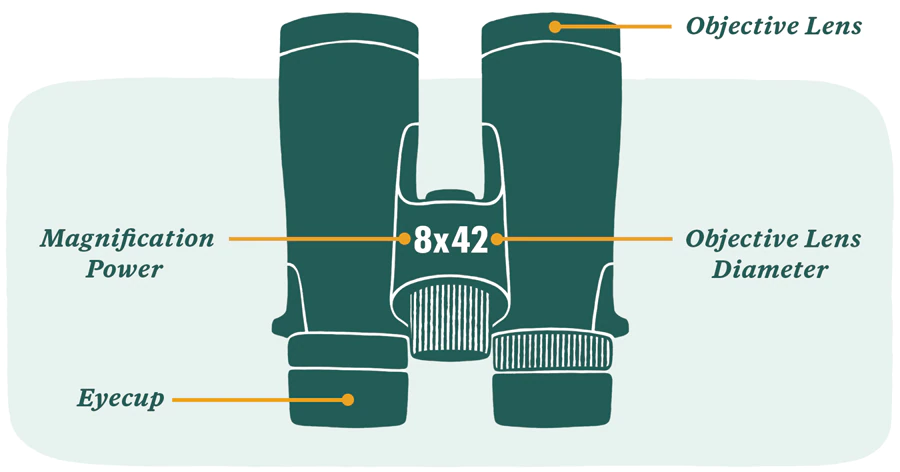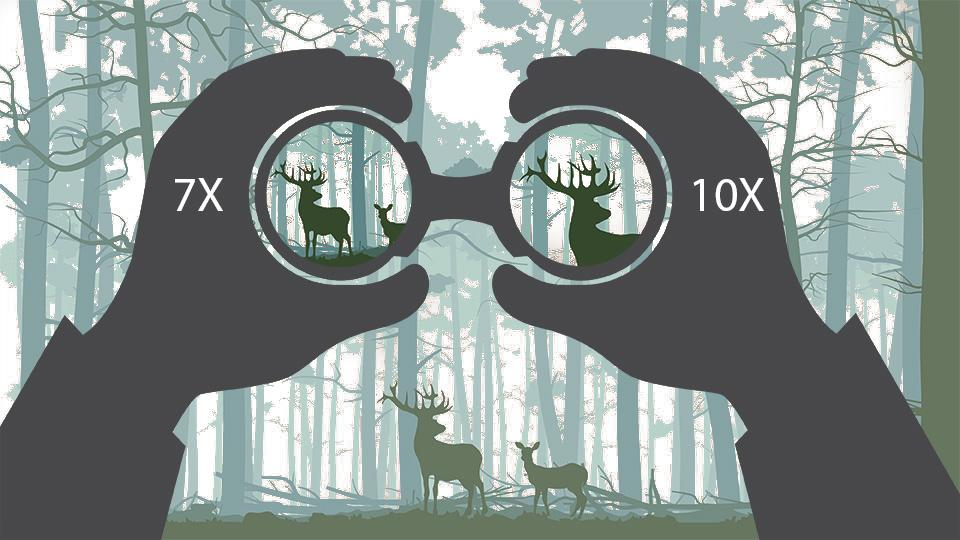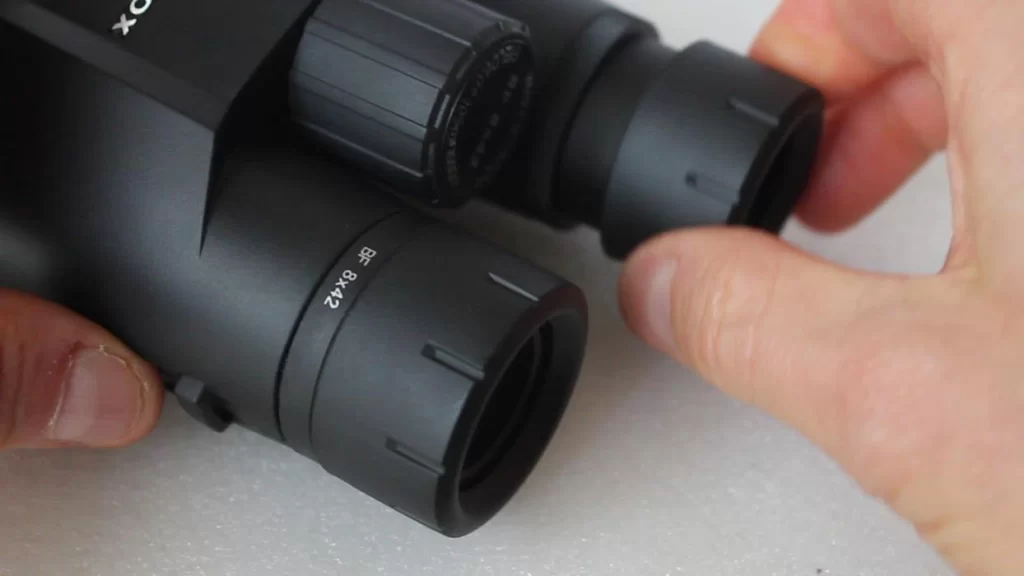You are here to know what binocular numbers mean and how this search helps you to make the right buying decision in the first attempt. Usually, you see binocular names have some digits and letters with them, for example, 8×42 mm and 10×50 mm.
So, what these numbers say, in this article, I’ll tell you all about what binocular numbers mean and some others that will be handy for you in making the right purchase.
In the explanation mentioned above, the first digit that was 8 or 10 with the addition of X indicates the magnification power of binoculars. It tells how far you can see or how many times you can enlarge the long distant object’s image.
For example, if it is 8, you can zoom in on the image by eight times. The next digit comes with mm, such as 42 and 50 mm. These figures show the objective lens diameter of binoculars.
The objective lens gathers the light, and the more this digit goes up, the higher the light it can collect for a better image of the object.
How to Read Binocular Numbers? (In Easy Way)
You can read them but cannot understand until and unless you develop a basic understanding of the numbers on binoculars. In this article, I’ll explain which pair of binocular magnification is better and what binocular magnification explained mean for perfect hunting and nature viewing.
And the process will begin by answering the question about how to read binocular numbers. So, firstly we’ll explain the magnification that comes with numbers like 8x, 10x, and 15x.
Magnification:
Magnification is one of the primary features that everyone looks at in binoculars. It varies with size, weight, and brands of binoculars. For a better and quality image, it starts from 7x, and you can have its latest models with increased magnification as you need.
When you initiate to know what binocular numbers mean, the first number you encounter is the magnification power. If you think about how far you can see with 10×50 binoculars. The answer would be 12 miles or more than that.
It becomes possible because of the mixture of the 10×50 mm combo. In this example, 10x is the booming power that gets the image closer by enlarging it. And you get to watch an image that was not visible to the naked eye. Then the 50 mm is the size of an objective lens for a great pair of binoculars.
As we described above, the more you get the increased size of the objective lens, the more light it will capture and submit to your eye for the ultimate crisp, bright and clear image through binoculars.
So, if you are a bird hunter, 7x or 8x is enough for the perfect birding. And if you are interested in deer hunting, coyote , or elk hunting, then you should acquire 10x or more than this.
The Objective Lens:
The objective lens is an essential part of binoculars, and it helps you get the right and improved amount of light for a better, bright, and clear image. In the 10x50mm, the 50 mm shows the size of the objective lens. It captures the light for your eye. If the lens is coated, it can perform much better.

If you aim to hunt or watch distant objects, you need exceptional support to cover the range and give you enough light to get a clear image of the object. Usually, it goes between 25 mm to 50 mm.
Of course, the higher you get, the more light it will capture and submit to you. But, when you increase the size of the objective lens, keep in mind that it affects the weight of binoculars quite significantly.
So, it would help if you kept binoculars within limits to ensure the lightweight and elevated amount of light. It has two primary coated glasses, the first one is a crown and the second one is a flint. The coated glasses, which come under 55, are crowns.
And the fewer ones are flint. So, to gain more power and more light for long distant objects, the crown helps you a lot, and in close distant hunting and watching flint glass plays a significant role.
Some Other Numbers:
Some other numbers do not come with binoculars, but they keep a very significant value for the optimum performance you want to achieve. Now, I’ll tell you about the field of view, exit pupil, and eye relief distance one after another.
Field of View:
It is the area that a camera or binoculars capture or cover. It has the direct bus inverse relation with magnification. Usually, the standard field of view goes between 300 ft to 380 ft at every 1000 yards. So, the more the distance in yards increases, the more field of view extends itself.

It gives your eye an option to look round and focus on the objects that are not in your intuitive focus, but with the help of its wider image range, you can look at the objects in your surroundings quickly.
You can shift your focus at any moment you want. To understand this scenario, you can also consider another article by clicking on how do binoculars work. In this article, I have explained the nitty-gritty of how binoculars perform and the major and minor contributors to attaining the max performance.
Exit Pupil:
It is the point that shows a bright circle that comes in the center of each eyepiece. It has different ranges for your eyes and can vary with the type and brand of binoculars.
But the standard exit pupil that most professionals refer to is 7 mm. And it usually comes under 2 to 4 mm. If we calculate it through a formula, that will go like, suppose you have a 10×50 mm combo, now 50÷10= 5mm.
So, now the 5 mm is the exit pupil that will support your vision with the other components. For knowing how it works to hunt, and viewing nature, you can read my other article, in which I gathered some great binoculars for elk hunting, and all have different exit pupils to know in detail; click on the best binoculars for elk hunting.
Eye Relief:
Eye relief is the distance between your eye and the eyecups of binoculars. Not all binoculars offer it; some do generously and rest to keep your eye in the safe zone.
Eye relief should be enough to allow you to use binoculars with or without glasses. The standard distance is 15 mm or more. So, if your binocular is offering you this space, you are good to go with that.

How much time you can use your binoculars in one go depends mainly on eye relief. It keeps your eyes safe from aches and rashes. It also helps you keep viewing up to the mark. To enjoy this super aid with maximum increased space, you can consider reading the best budget binoculars.
What Does 20×50 Mean on Binoculars?
As we discussed above, these figures come with names of binoculars on different online portals. The first digit 20x indicates the magnification power that helps you enjoy the closer shot of the target. You can enlarge the image by twenty times.
On the other hand, the following figure is 50, which means the size of the objective lens. It captures the light, and the amount of light collection entirely depends on the size of the objective lens.
Usually, 42 mm size is enough for hunting, viewing and wildlife chasing. And if you are thinking, are 30×60 binoculars good or not. So, these are super good for long-distance hunting and viewing.
How to Read Binocular Sizes?
If you have gone through the details above, you must know what the binoculars size chart says and how to read it. What do 30×60 binoculars mean, or which binocular magnification is better? The understanding of the numbers are the answers of these questions.
In the 30×60 combo, the first half shows the zoom-in power, and the second half tells how bigger the size of the objective lens is.
How Far Can You See with 30×60 Binoculars?
The 30×60 is indeed a powerful and unusual combination of magnification and the objective lens. So, you can attain a 378 ft accurate view every 1000 yards. As you increase the distance in yards, with the same proportion, the objective view goes wider.
If the space is 2000 yards, you can have 756 ft view coverage, and if you make the distance half, 500 yards, the view will shrink to 189 ft. And it goes the same way.
We have almost covered all the technical details in this manual on what binocular numbers mean. Now, you must be fully aware of what numbers mean and what is the value of knowing them before you buy a pair of binoculars. We hope this article would have helped you to find the binocular you were missing in your sports kit. Now, you can make the right decision for a set of binoculars that suits your needs and anticipations. If you follow the details above and ensure them in your consideration, you will surely earn the best binocular you have ever had so far.
Final Words